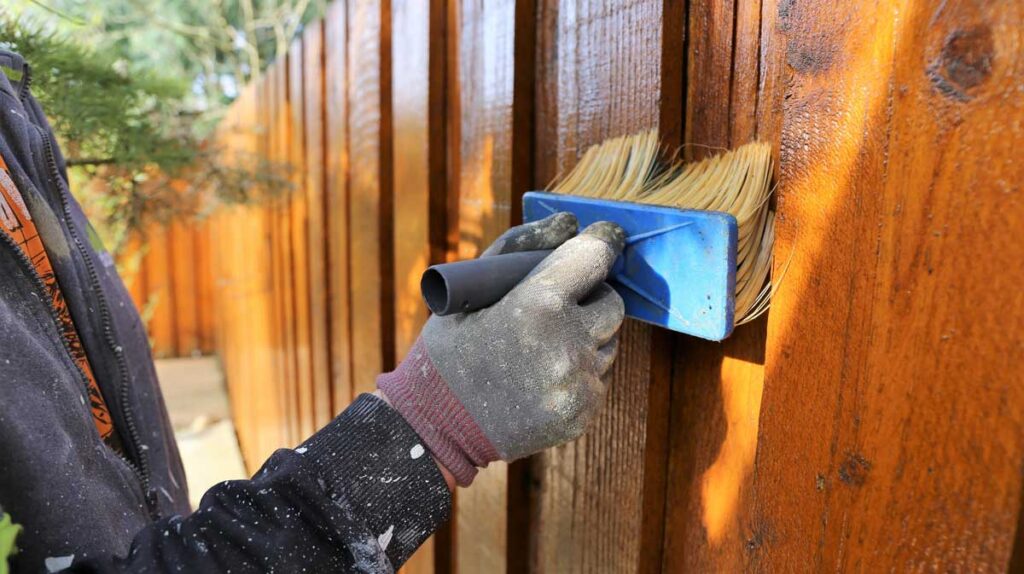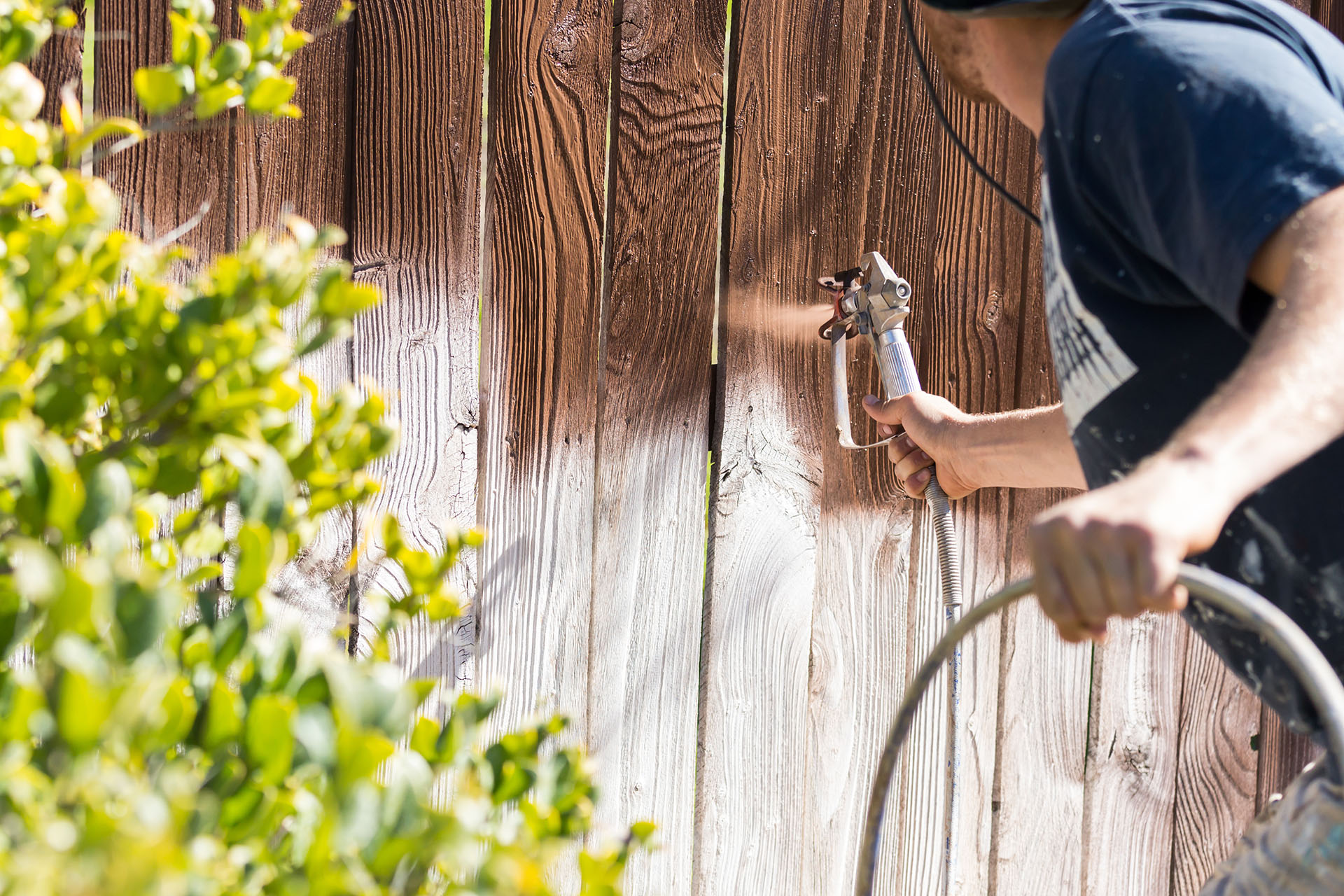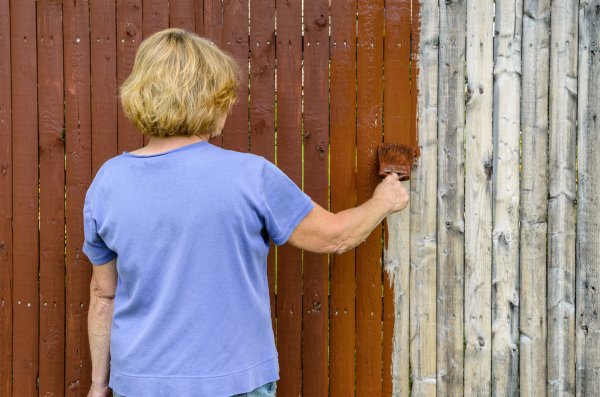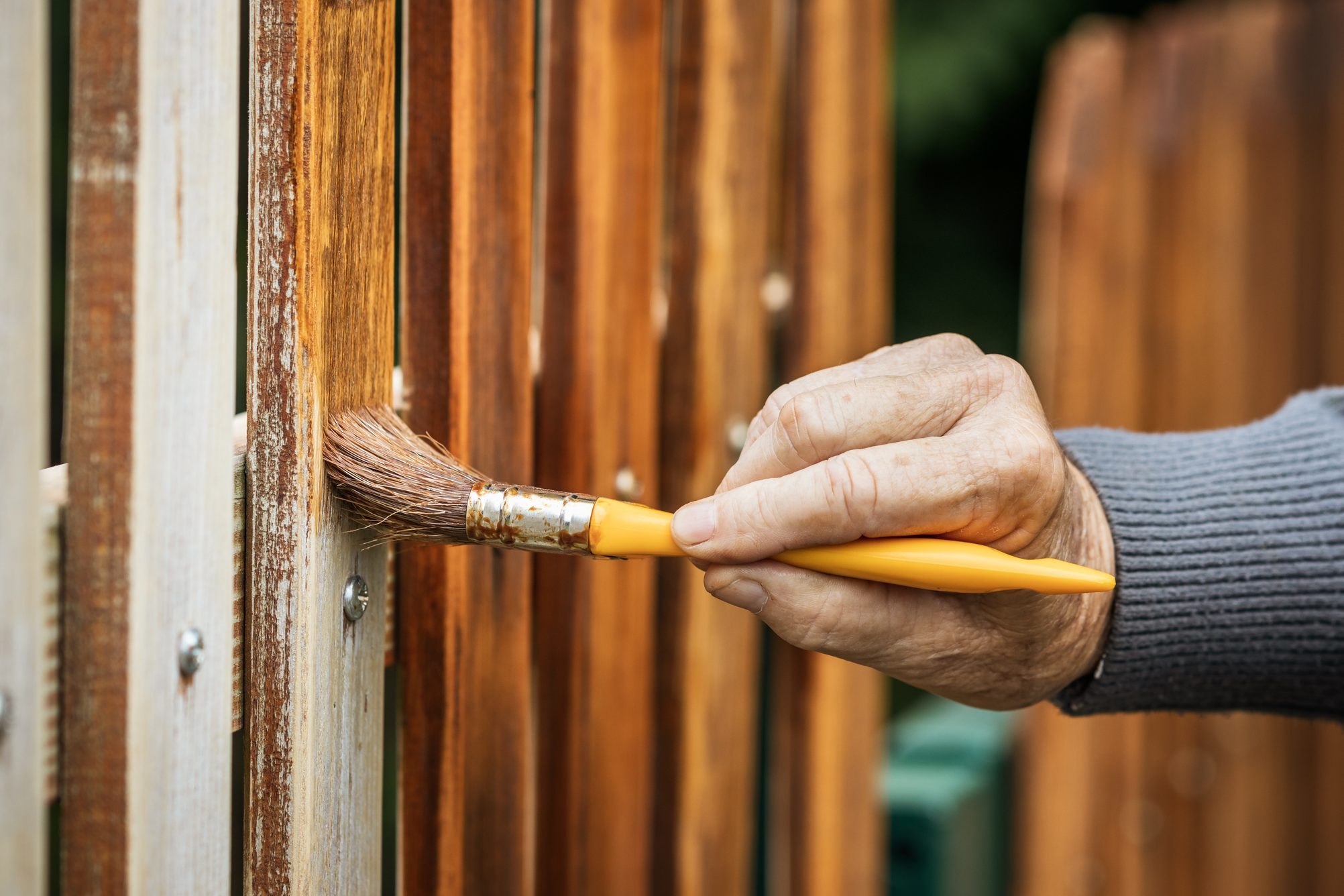Are you looking to learn more about fence staining and painting? Wondering how to properly maintain and enhance the appearance of your fence? Well, you’ve come to the right place! In this article, we’ll dive into the world of fence staining and painting and provide you with some tips and tricks to make the process easier and more effective. Whether you’re a DIY enthusiast or hiring professionals, we’ve got you covered!
When it comes to fence staining and painting, there are a few important factors to consider. First and foremost, choosing the right type of stain or paint for your fence is crucial. We’ll discuss the different options available and help you weigh the pros and cons of each. Additionally, we’ll delve into the preparation process, including cleaning and sanding the fence surface to ensure a smooth and long-lasting finish. Whether you’re dealing with a brand new fence or rejuvenating an older one, we’ll provide you with step-by-step instructions to achieve the best results. And if you’re not sure how to choose the perfect color for your fence, we’ll give you some tips on that too! So, stay tuned and get ready to become a fence staining and painting pro!
Fence Staining and Painting Tips
Fences serve as both functional and aesthetic components of your outdoor space. They provide privacy, security, and define the boundaries of your property. However, over time, the sun, rain, and other weather elements can cause damage to the wood, leading to deterioration and a less appealing appearance. To preserve the beauty and extend the lifespan of your fence, fence staining and painting are essential. In this article, we will explore the benefits of fence staining and painting, discuss how to choose the right stain or paint, provide step-by-step instructions, and offer maintenance tips.

Benefits of Fence Staining and Painting
Enhances the Appearance of Your Fence
One of the primary reasons homeowners invest in fence staining and painting is to enhance the overall appearance of their fence. Over time, natural wood can fade, gray, and become weathered, diminishing the visual appeal of your property. By staining or painting your fence, you can revitalize its appearance, transforming it into a beautiful and eye-catching feature of your outdoor space.
Protects Your Fence from Weather Damage
Exposure to the elements can take a toll on your fence. Rain, snow, UV rays, and fluctuating temperatures can cause the wood to rot, warp, or crack. Fence staining and painting act as a protective barrier, preventing moisture penetration and minimizing the effects of weather damage. A properly stained or painted fence can withstand the elements for longer periods, saving you the cost and hassle of frequent repairs or replacements.
Increases the Lifespan of Your Fence
A well-maintained fence can serve you for many years. By applying a protective coating through staining or painting, you significantly increase the lifespan of your fence. The stain or paint acts as a barrier against moisture, sunlight, and pests, preventing premature degradation of the wood. Regular maintenance and proper application techniques contribute to a long-lasting fence that adds value to your property.
Choosing the Right Stain or Paint for Your Fence
When it comes to fence staining and painting, selecting the appropriate stain or paint is crucial for achieving the desired results. Here are some factors to consider when choosing the right product for your fence:
Consider the Fence Material
The type of material your fence is made of plays a significant role in determining the appropriate stain or paint. Different materials, such as wood, metal, vinyl, or composite, may require specific products or preparation techniques. Make sure to choose a stain or paint that is compatible with your fence material to ensure optimal results and durability.
Decide Between Stain or Paint
Deciding whether to stain or paint your fence involves considering both aesthetic preferences and functional requirements. Stain penetrates the wood, allowing the natural grain and texture to show through, while paint forms a solid colored coating on the surface. Stain provides a more natural look, while paint offers a wider range of color options. Consider the desired look, maintenance needs, and protection level when deciding between stain or paint for your fence.
Select the Appropriate Color
Choosing the right color for your stained or painted fence can significantly impact the overall aesthetics of your outdoor space. Factors such as the architecture of your home, landscape design, and personal preference should influence your color selection. Neutral tones, such as browns and grays, tend to blend well with various surroundings, while bolder colors can create a more vibrant and eye-catching appearance.

Preparing Your Fence for Staining or Painting
Proper preparation of your fence is crucial before applying stain or paint. Following these steps will help ensure a smooth and long-lasting finish:
Clean the Fence Thoroughly
Before staining or painting, it’s essential to clean your fence thoroughly to remove dirt, debris, mildew, and any loose or peeling paint. Use a power washer or a scrub brush with a mixture of water and mild detergent to scrub the surface. Rinse the fence with water and allow it to dry completely before proceeding with the next steps.
Repair Any Damaged Areas
Inspect your fence for any damages, such as loose boards, nails, or splintering wood. Repair or replace any faulty components to ensure a solid and stable structure. Addressing these issues before staining or painting will help maintain the integrity of your fence and prevent further damage.
Sand the Surface for a Smooth Finish
To achieve a smooth and even surface, sanding is necessary, especially if there are rough spots or old paint remnants. Use a medium-grit sandpaper to remove any imperfections or rough edges. Sanding also helps the stain or paint adhere better to the wood surface, ensuring better longevity and coverage.
Steps to Stain Your Fence
Staining your fence requires specific steps and techniques to achieve a professional-looking finish that protects the wood. Follow these guidelines for successful fence staining:
Apply a Wood Cleaner or Brightener
Before staining, it is recommended to apply a wood cleaner or brightener to open up the pores of the wood and remove any remaining dirt or residue. Follow the product instructions and allow the cleaner to work for the specified time before rinsing it off.
Use a Brush, Roller, or Sprayer
When applying the stain, you have several options depending on your preference and the size of your fence. A brush allows for better control and application on vertical surfaces, while a roller is efficient for larger areas. Sprayers can provide quick and even coverage but require proper technique to avoid overspray. Choose the method that suits your needs and apply the stain evenly, following the wood grain.
Allow Sufficient Drying Time
After applying the stain, allow it to dry according to the manufacturer’s instructions. It’s crucial to avoid any contact or interference with the fence during this time to prevent smudging or unevenness. Ensure proper ventilation to facilitate the drying process and protect the freshly stained fence from dust or debris.

Steps to Paint Your Fence
Painting your fence offers a more versatile color selection and can provide a solid and even finish. Follow these steps for successful fence painting:
Apply a Primer
Priming the surface before painting helps promote better adhesion and improves the longevity of the paint. Choose a primer suitable for your fence material and apply it evenly using a brush or roller. Allow the primer to fully dry before proceeding with the paint application.
Use a Brush or Paint Sprayer
When it comes to painting your fence, a brush or paint sprayer can be used depending on your preference and the size of the area. A brush allows for better control and precision, especially when painting intricate details or near other surfaces. Paint sprayers provide quicker application but require proper technique to avoid overspray. Apply the paint evenly, following the wood grain for optimal coverage.
Apply Multiple Coats for Even Coverage
To achieve a solid and even color, it is recommended to apply multiple coats of paint. Allow each coat to dry completely before applying the next layer. Multiple coats ensure better longevity and protection against the elements. Follow the paint manufacturer’s instructions regarding the recommended drying time between coats.
Proper Techniques for Fence Staining
To achieve the best results when staining your fence, it’s essential to follow proper techniques and guidelines:
Staining Vertical or Horizontal Boards
When applying stain to a fence with vertical boards, it’s advisable to work from the top down, allowing any drips to be absorbed as you progress. For fences with horizontal boards, work from one end to the other, following the wood grain to prevent uneven staining.
Using a Stain Pad or Brush
A stain pad or brush will help ensure an even and smooth application of the stain. Maintain a consistent pressure and direction, working in small sections at a time. This technique minimizes the risk of overlapping or leaving noticeable brush marks on the fence.
Avoiding Overlapping or Dripping
Overlap marks or drips can spoil the appearance of your stained fence. To avoid this, it’s crucial to control the amount of stain on your applicator and maintain a steady hand. Excess stain should be brushed out or absorbed before moving on to the next section. Pay attention to areas where stain may accumulate, such as corners or joints, and ensure proper blending.

Proper Techniques for Fence Painting
When painting your fence, applying the paint properly is essential to achieve a smooth and consistent finish:
Painting with Even Strokes
To achieve an even and professional look, paint with smooth and consistent strokes, following the wood grain. Maintain a steady hand and avoid excessive pressure or uneven coverage. If using a brush, overlap each stroke slightly to ensure seamless application. For a paint sprayer, maintain a consistent distance and speed to avoid uneven distribution.
Applying Thin Layers
It’s better to apply multiple thin layers of paint rather than one thick coat. Thick layers can lead to uneven drying and decreased durability. Allow each layer to dry fully before applying the next, and ensure proper coverage for optimal protection and color intensity.
Avoiding Paint Runs or Drips
To prevent paint runs or drips, avoid excessive paint accumulation on the brush or sprayer. Wipe off any excess before starting, and frequently check for any buildup during the painting process. If drips occur, quickly smooth them out to avoid visible marks. Proper technique and control will help achieve a flawless and professional finish.
Maintaining a Stained Fence
To ensure the longevity and beauty of your stained fence, regular maintenance is essential. Follow these tips to keep your stained fence in top condition:
Regular Cleaning and Inspection
Regularly clean your stained fence to remove dirt, grime, and mold. Use a mild detergent and water, and scrub gently with a soft brush or sponge. Inspect the fence for any signs of damage, such as peeling or fading stain, and address any issues promptly to prevent further deterioration.
Periodic Reapplication of Stain
Over time, the stain on your fence may fade or wear down due to weather exposure. Depending on the stain type and environmental factors, periodic reapplication may be necessary. Follow the manufacturer’s recommendations for reapplication intervals, and ensure proper cleaning and preparation before applying the new coat of stain.
Addressing Any Damage or Wear
If your stained fence experiences any damage, such as cracks, warping, or rot, take immediate action to address the issue. Repair or replace any damaged boards or components to maintain the structural integrity of your fence. Ignoring or delaying repairs can lead to more significant problems and compromise the lifespan of your fence.

Maintaining a Painted Fence
Painted fences also require regular maintenance to preserve their appearance and protective properties. Here are some tips for maintaining a painted fence:
Cleaning Off Dirt or Debris
Regularly clean your painted fence to remove dirt, dust, or any other debris that may accumulate over time. Use a mild detergent and water, gentle scrubbing, and rinse thoroughly. Avoid harsh cleaning solutions or abrasive materials that can damage the paint.
Touching Up Paint as Needed
Monitor your painted fence for any signs of chipping, peeling, or fading paint. Promptly address these areas by sanding the damaged spot lightly, applying an appropriate primer if necessary, and touching up the paint. Properly maintaining the paint finish will help minimize wear and prevent further damage.
Repainting Every Few Years
The lifespan of paint on a fence varies depending on factors such as climate, exposure, and quality of paint used. Keep an eye on the condition of your painted fence, and consider repainting every few years or when signs of significant wear become apparent. Proper surface preparation and application techniques will ensure a smooth and long-lasting paint finish.
Common Mistakes to Avoid When Staining or Painting Your Fence
To achieve the best results when staining or painting your fence, it’s important to avoid common mistakes that can compromise the outcome and durability. Here are some mistakes to avoid:
Not Preparing the Surface Properly
Skipping or neglecting proper surface preparation can lead to poor adhesion and premature paint or stain failure. Take the time to clean, repair, and sand your fence before applying any coating. This will create a smooth and stable foundation for optimal results.
Using an Incompatible Stain or Paint
Using a stain or paint that is not suitable for your fence material can result in poor adhesion, color inconsistency, or premature deterioration. Always choose a product specifically designed for your fence material and follow the manufacturer’s instructions for application and maintenance.
Neglecting Maintenance and Touch-Ups
Even with high-quality stain or paint, regular maintenance and touch-ups are crucial to keeping your fence in top condition. Failure to address small damages or wear can lead to more significant problems over time. Stay on top of maintenance tasks and address any issues promptly to maximize the lifespan and appearance of your fence.
Safety Tips for Fence Staining and Painting
Staining or painting your fence involves working with chemicals and tools that require caution and proper safety measures. Ensure your safety by following these tips:
Wear Protective Clothing and Gear
When staining or painting, wear appropriate protective clothing such as long sleeves, pants, gloves, and safety goggles. These will protect you from skin contact with chemicals, potential splatters, and eye injuries. Additionally, consider wearing a mask to prevent inhaling dust particles or fumes.
Use Proper Ventilation
When working with stain or paint, ensure proper ventilation in your workspace. If working indoors, open windows and use fans to circulate fresh air. If working outdoors, choose a day with mild wind conditions to prevent overspray or inhalation of fumes.
Handle Stain or Paint Chemicals with Care
Stain and paint chemicals can be harmful if ingested or come into contact with your skin. Follow the manufacturer’s instructions for handling, storing, and disposing of these products. Keep them out of the reach of children and pets.
Cost Considerations for Fence Staining and Painting
The cost of fence staining or painting can vary depending on several factors. Consider the following cost considerations:
Factors Affecting Staining or Painting Costs
The size of your fence, the type of stain or paint chosen, and whether you decide to hire professionals all contribute to the overall cost. Additionally, factors such as the condition of your fence, the need for repairs, and any special treatments required can impact the total expenses.
Comparing the Costs of DIY vs. Professional Services
Deciding whether to stain or paint your fence yourself or hire professionals involves weighing the costs and benefits. DIY projects may save you money initially, but consider the time, effort, and potential for errors. Professional services offer expertise and efficiency, ensuring high-quality results but may come at a higher price.
Budgeting for Future Maintenance
In addition to the initial staining or painting costs, it’s essential to consider future maintenance expenses. This includes periodic cleaning, touch-ups, and eventual recoating. Proper maintenance significantly extends the lifespan of your fence, reducing the need for frequent repairs or replacements.
Common Questions About Fence Staining and Painting
Here are some frequently asked questions regarding fence staining and painting:
How Long Does Stain or Paint Last on a Fence?
The lifespan of stain or paint on a fence can vary depending on various factors, such as the quality of the product, exposure to weather elements, and maintenance. Generally, stain can last anywhere from 2 to 10 years, while painted fences may require repainting every 5 to 10 years.
Can I Stain or Paint Over an Existing Finish?
In most cases, it is possible to stain or paint over an existing finish on your fence, as long as the surface is adequately prepared. Ensure the previous coating is clean, smooth, and free of loose or peeling paint. Depending on the condition and compatibility of the existing finish, priming or additional preparation may be necessary.
What Should I Do if Stain or Paint Peels or Fades?
If the stain or paint on your fence starts to peel or fade, it’s important to address the issue promptly. Begin by removing any loose or peeling coating and sanding the affected area. Clean the surface thoroughly, and follow the appropriate steps for recoating, such as applying a primer or additional coats of paint or stain. Proper maintenance and regular inspections will help catch such issues early on.
Conclusion
Enhancing and protecting your fence through staining or painting is a valuable investment. By following proper techniques and maintenance, you can enjoy a beautiful and long-lasting fence. Fence staining and painting not only improve the appearance of your outdoor space but also extend the lifespan of your fence, protecting it from weather damage. With the right stain or paint, appropriate preparation, and regular maintenance, your fence will continue to add beauty, privacy, and security to your property for years to come.